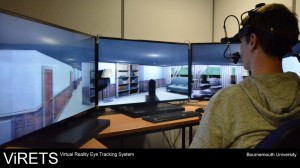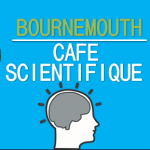We would like to invite you to the next research seminar of the Creative Technology Research Centre that will be delivered by Chris Ramsey.
Title: Developing ViRETS – A Virtual Reality Eye-Tracking System
Time: 2:00PM-3:00PM
Date: Wednesday 3rd December 2014
Room: P335, Poole House, Talbot Campus
Abstract:
This research project aims to develop a Virtual Reality Eye-Tracking System (VIRETS), capable of displaying naturalistic viewing conditions with high ecological validity and large field of view (FOV) in order to investigate the effects on human gaze behaviour (including head movement) and how this could be advantageous when looking at methods for visual cognition experiments. Static, lab-based eye trackers (head-mounted or desk-mounted) are accurate and easy to calibrate. However, they have traditionally made use of single screen setups with a FOV which doesn’t provide realistic viewing conditions. Furthermore, the head of a participant often has to be restricted using a chin rest and/or bite bar, or, in the case of head-mounted eye-trackers, restricted to small movements, which prohibits naturalistic head movements.
While mobile eye-trackers bring eye-tracking research to real world scenarios, allowing for naturalistic head and eye movements and allowing for naturalistic viewing conditions, the method presents a number of limitations, such as lower frequencies and the possibility of dropped frames. Although video footage can be layered with gaze behaviour to show saccadic eye-movement in real scenes, data analysis has to be carried out offline and can be time consuming: Specifically, video footage must be inspected frame by frame, labelled and described in order to analyse what objects in the scene participants attend to. Furthermore using real-world scenarios make it difficult to control all the stimuli presented, making the interpretation of cause and effect relationships difficult.
ViRETS aims to address these concerns by combining realistic and immersive VR, head-mounted eye-tracking, motion tracking and the freedom of naturalistic head movement. By these means we’ll investigate how an increased FOV affects gaze behaviour, head movements and performance specifically in the context of visual search and navigation.
We hope to see you there.
 Cafe Scientifique: How can Virtual Reality be used to support our students’ learning?
Cafe Scientifique: How can Virtual Reality be used to support our students’ learning?










 New Nepal scoping review on maternal & neonatal health
New Nepal scoping review on maternal & neonatal health Fourth INRC Symposium: From Clinical Applications to Neuro-Inspired Computation
Fourth INRC Symposium: From Clinical Applications to Neuro-Inspired Computation Writing policy briefs
Writing policy briefs Upholding Excellence: The Concordat to Support Research Integrity
Upholding Excellence: The Concordat to Support Research Integrity ECR Funding Open Call: Research Culture & Community Grant – Application Deadline Friday 12 December
ECR Funding Open Call: Research Culture & Community Grant – Application Deadline Friday 12 December MSCA Postdoctoral Fellowships 2025 Call
MSCA Postdoctoral Fellowships 2025 Call ERC Advanced Grant 2025 Webinar
ERC Advanced Grant 2025 Webinar Horizon Europe Work Programme 2025 Published
Horizon Europe Work Programme 2025 Published Horizon Europe 2025 Work Programme pre-Published
Horizon Europe 2025 Work Programme pre-Published Update on UKRO services
Update on UKRO services European research project exploring use of ‘virtual twins’ to better manage metabolic associated fatty liver disease
European research project exploring use of ‘virtual twins’ to better manage metabolic associated fatty liver disease